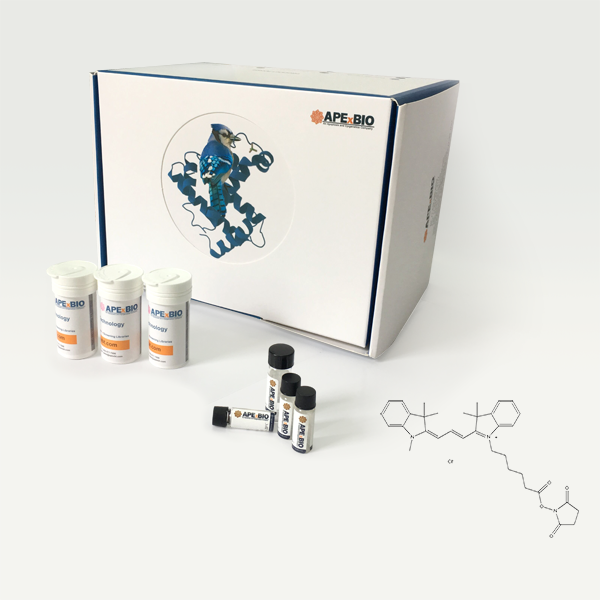Cy3 NHS ester (non-sulfonated)
Catalogue Number: A8100-APE
| Manufacturer: | Apexbio |
| Shelf Life: | 24 months |
| Molecular Formula: | C34H40ClN3O4 |
| Physical state: | A solid |
| Type: | Fluorescent Reagents |
| Shipping Condition: | Blue Ice |
| Unit(s): | 10 mM (in 1mL DMSO), 25 mg, 5 mg |
Description
Description: Cyanine, a kind of synthetic dye belonging to the polymethine group, is still used in industry to increase the sensitivity range of photographic emulsions (such as increasing the wavelength range and making the film panchromatic), and in biotechnology more recently. As fluorescent dyes, cyanines have been particularly used in biomedical imaging. Depending on their structure, cyanines can cover the spectrum from UV to IR.Cy3 NHS ester, a reactive dye for labeling of amino-groups in biomolecules, is a Cy3® NHS ester analog. This reagent is commonly used for the labeling of soluble proteins, peptides, and oligonucleotides or DNA. Cy3 NHS ester requires the use of organic co-solvent (such as DMF, or DMSO) for the labeling, however, considering the usage of water-soluble sulfo-Cy3 NHS ester for delicate proteins, such co-solvent is not necessary. Cy3 fluoresce is in the orange region (~550 nm excitation, ~570 nm emission), while Cy5 is fluorescent in the red (~650/670 nm) but absorbs in the orange (~649 nm). Cy3 can be monitored by fluorometers, imagers, and microscopes with standard Tetramethylrhodamine (TRITC) filters. Due to its inherently high extinction coefficient, Cy3 is even detected by naked eye on gels and in solution easily.Reference:http://en. wikipedia.org/wiki/Cyanine
Additional Text
Short Description
Labeling of amino-groups in biomolecules.
Reagent:Smile String
CC1(C2=CC=CC=C2[N+](=C1C=CC=C3C(C4=CC=CC=C4N3CCCCCC(=O)ON5C(=O)CCC5=O)(C)C)C)C
Solubility
≥59 mg/mL in DMSO; insoluble in H2O; ≥25.3 mg/mL in EtOH with ultrasonic
Storage Note
24 months after receival at -20°C in the dark. Transportation: at room temperature for up to 3 weeks. Avoid prolonged exposure to light. Desiccate.
